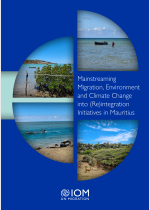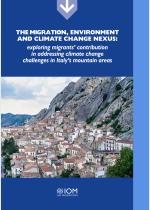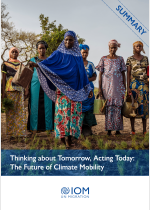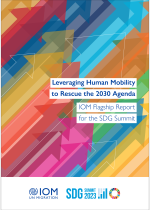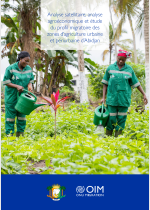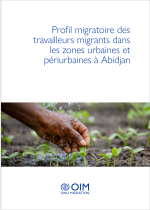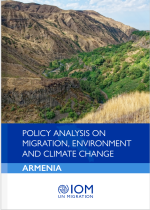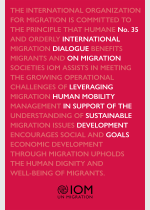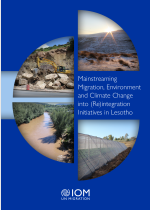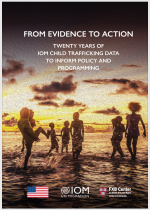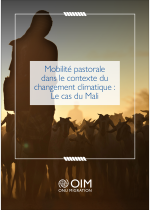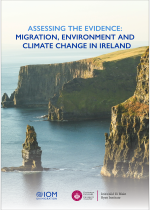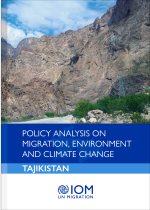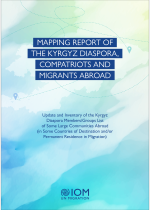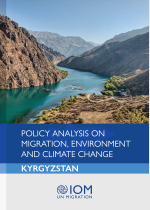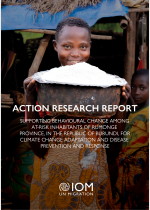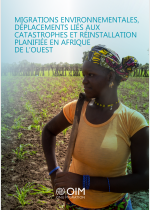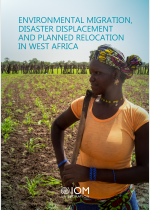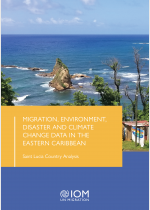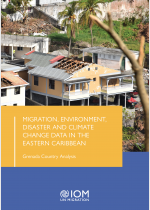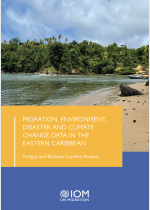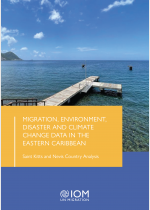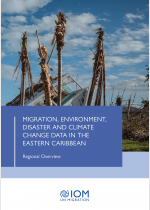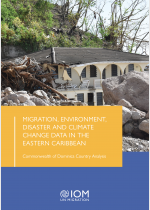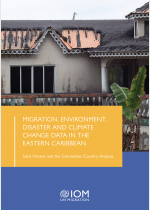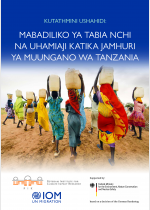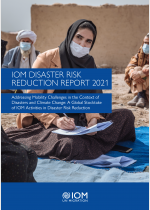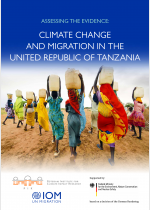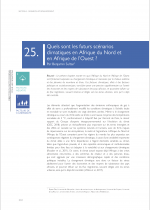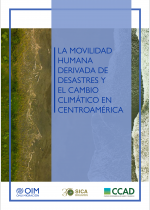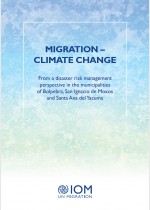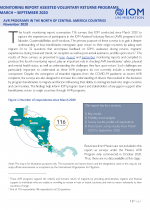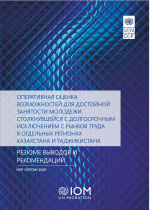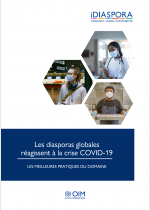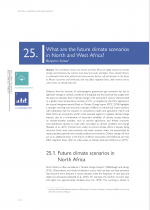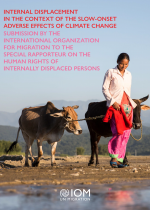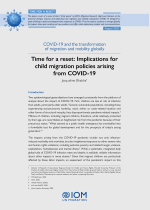Rechercher des livres
Displaying 1 - 50 of 146
The International Organization for Migration (IOM) and the African Development Bank (AfDB) have produced this joint report examining topical migration issues for Africa. The report entitled Diaspora Engagement, Climate-Induced Migration and Skills Mobility: A focus on Africa, provides critical… Read More
Enhancing the coherence between migration and climate action policy within the European Union’s internal and external policy should be a priority in the context of the envisaged green transition in the European Union. This report argues that the European Green Deal, which is a focus of this report… Read More
Environment and climate change affect a wide range of people (including internal, inward and outward migrants) throughout the migration process by limiting their livelihood options and available natural resources. Livelihoods in Southern Africa particularly depend on natural resources, which are… Read More
Cross-border pastoralism is practiced throughout West and Central Africa. It is observed to varying degrees in all countries in the Region, where it constitutes a significant means of subsistence and ecosystem maintenance predicated on the sustainable use of vegetation and adaptive resource… Read More
Migration in a changing climate can be both a reaction to negative environmental impacts and a driver of resilience and climate change adaptation. In rural and fragile areas of the Global North, migration can contribute to mitigate the socioeconomic effects of depopulation, demographic ageing and… Read More
The global response to climate change is at a crossroads. The United Nations Intergovernmental Panel on Climate Change (IPCC), in its sixth assessment report summary for policymakers, notes that it is “more likely than not” that global average temperature increase will surpass 1.5 °C in the coming… Read More
The IOM Flagship Report “Leveraging Human Mobility to Rescue the 2030 Agenda” is the first of its kind in terms of its scope, and a central contribution of IOM to the 2023 Sustainable Development Goals Summit (SDG Summit).
A travers le projet “Protection et insertion de la main d’œuvre migrante et environnement dans l’agriculture urbaine et périurbaine au Sénégal et en Côte d’Ivoire” (MITSA), financé par la France, l’OIM propose de revaloriser le travail des migrants du secteur agricole en se focalisant sur les zones… Read More
Le profil migratoire permet d’établir les profils de migration de travail dans les zones d’étude sélectionnées par l'analyse satellitaire, à savoir : Adiopodoumé, Anyama et Bingerville dans le Grand-Abidjan, Côte d’Ivoire. Cette étape de la recherche permet non seulement de caractériser les… Read More
The study aims to increase understanding of how and to what extent migration in the context of climate change and environmental degradation has been mainstreamed into Armenian national policy, legal and strategic documents. The methodology for this mapping exercise comprises two major steps: First… Read More
The global response to climate change is at a crossroads. The United Nations Intergovernmental Panel on Climate Change (IPCC), in its sixth assessment report summary for policymakers, notes that it is “more likely than not” that global average temperature increase will surpass 1.5 °C in the coming… Read More
The first session of International Dialogue on Migration (IDM) 2023 took place on 30 and 31 March 2023, with the theme, Leveraging Human Mobility in Support of the Sustainable Development Goals (SDGs). The session took place at a crucial time in light of the imminent SDG Summit in September, which… Read More
A travers le projet “Protection et insertion de la main d’œuvre migrante et environnement dans l’agriculture urbaine et périurbaine au Sénégal et en Côte d’Ivoire” (MITSA), financé par la France, l’OIM propose de revaloriser le travail des migrants du secteur agricole en se focalisant sur les zones… Read More
This report, “International Labour Migration in a Changing Climate”, provides insights from Malaysia and Thailand on how, and in what contexts, international labour migration can be a viable adaptation strategy to climate change. The report provides experiences and perspectives of migrant workers,… Read More
As already manifesting in many parts of Southern Africa, for instance, severe droughts, windstorms, land degradation, heavy rainfall and snowstorms are adversely affecting agriculture production in Lesotho. Besides climate and environmental change impact on agricultural productivity, the decline in… Read More
From Evidence to Action: Twenty years of IOM child trafficking data to inform policy and programming
La transhumance transfrontalière est une occupation courante en Afrique de l'Ouest et du Centre : elle est constatée à des degrés divers dans tous les pays de la région, et contribue de manière significative aux moyens de subsistance dans la région ainsi qu’au maintien des écosystèmes, avec au… Read More
The publication Assessing the Evidence: Migration, Environment and Climate Change in Ireland aims to contribute to the knowledge base on changing migration patterns in Ireland, in the context of a warming planet and increasing environmental degradation. This Country Profile aims to inform and… Read More
Les mouvements de population dans les pays de l’Afrique de l’Ouest ont une tradition de longue date. Ils sont vus comme un élément clé pour les stratégies d’amélioration des moyens d’existence, et une stratégie d’adaptation face aux facteurs de stress climatique. Plusieurs facteurs, comme les… Read More
Over the last decade, there has been a rise in global awareness of human mobility in the context of climate change and environmental degradation. For both policy and cooperation on climate and human mobility, concern remains with creating conditions that enable people to have the option to safely… Read More
Air Pollution and Its Health Impacts on Internal Migrants in Bishkek, Kyrgyzstan - Assessment Report
Обновление и инвентаризация списка членов и групп кыргызской диаспоры кыргызстанцев в некоторых крупных сообществ за рубежом (в странах назначения и/или постоянного проживания в миграции)
Modern slavery is the very antithesis of social justice and sustainable development. The 2021 Global Estimates indicate there are 50 million people in situations of modern slavery on any given day, either forced to work against their will or in a marriage that they were forced into. This number… Read More
This Mapping Report of the Kyrgyz Diaspora, Compatriots and Migrants Abroad was commissioned by IOM within the framework of the project titled “Leveraging Diaspora Funding into Climate Action” funded by the IOM Development Fund and managed by IOM Kyrgyzstan in collaboration with the government and… Read More
For both policy and cooperation in the area of climate and human mobility, the significant concern remains with creating conditions that enable people to have options to safely stay, to leverage the full potential benefits of dignified migration, and to avert, minimize and address displacement and… Read More
This report highlights the methodologies, results and lessons learned from the project Enhancing Natural Disaster Preparedness and Response Capacity in at-Risk Communities in Burundi, funded by the IOM Development Fund and implemented by IOM Burundi between September 2019 and August 2021.
L’Afrique de l’Ouest a une longue tradition de mobilité humaine liée aux changements environnementaux. La majorité des mouvements est interne et intrarégionale et se fait principalement entre pays voisins. L’Afrique de l’Ouest est également l’une des régions les plus vulnérables du monde en ce qui… Read More
West Africa carries a long history of human mobility in relation to environmental changes, and intraregional mobility still represents the most significant feature of migration in the region. Besides being among the most highly affected by climate change in the future, the West Africa region needs… Read More
The reports entitled Migration, Environment, Disaster and Climate Change Data in the Eastern Caribbean are based on a regional study assessing the national and regional data systems on migration, environment, disasters and climate change across the Eastern Caribbean. The set of reports includes one… Read More
The reports entitled Migration, Environment, Disaster and Climate Change Data in the Eastern Caribbean are based on a regional study assessing the national and regional data systems on migration, environment, disasters and climate change across the Eastern Caribbean. The set of reports includes one… Read More
The reports entitled Migration, Environment, Disaster and Climate Change Data in the Eastern Caribbean are based on a regional study assessing the national and regional data systems on migration, environment, disasters and climate change across the Eastern Caribbean. The set of reports includes one… Read More
The reports entitled Migration, Environment, Disaster and Climate Change Data in the Eastern Caribbean are based on a regional study assessing the national and regional data systems on migration, environment, disasters and climate change across the Eastern Caribbean. The set of reports includes one… Read More
Migration, Environment, Disaster and Climate Change Data in the Eastern Caribbean: Regional Overview
The reports entitled Migration, Environment, Disaster and Climate Change Data in the Eastern Caribbean are based on a regional study assessing the national and regional data systems on migration, environment, disasters and climate change across the Eastern Caribbean. The set of reports includes one… Read More
The reports entitled Migration, Environment, Disaster and Climate Change Data in the Eastern Caribbean are based on a regional study assessing the national and regional data systems on migration, environment, disasters and climate change across the Eastern Caribbean. The set of reports includes one… Read More
This summary brief in Swahili accompanies the English-language publication Assessing the Evidence: Migration, Environment and Climate Change in the United Republic of Tanzania and is intended for use by policymakers and practitioners.
Increasing numbers of people are displaced or compelled to migrate every year due to disasters and environmental stressors. It is expected that disasters – amplified by factors, such as climate change, unsustainable ecosystem use, conflict, urbanization and water scarcity – will intensify, and that… Read More
The publication Assessing the Evidence: Migration, Environment and Climate Change in the United Republic of Tanzania attempts to comprehensively address climate change impacts in the United Republic of Tanzania, current mobility patterns and trends, and the possible linkages between them. The… Read More
Le présent chapitre étudie l’incidence des facteurs climatiques et environnementaux sur la migration dans les pays situés le long de la route de la Méditerranée centrale. S’appuyant sur une analyse de la littérature sur le sujet, il met en relief la complexité de ces liens, notamment les… Read More
Le présent chapitre montre en quoi l’Afrique du Nord et l’Afrique de l’Ouest sont fortement exposées au changement climatique et menacées par la chaleur extrême et des pénuries de nourriture et d’eau. Ces facteurs climatiques, alliés à des facteurs politiques et socioéconomiques, vont faire peser… Read More
El nexo entre migración, desastres, degradación ambiental y cambio climático ha recibido un interés creciente dentro del espacio político de América Central, así como en los trabajos académicos y en la agenda de cooperación internacional.
En consecuencia, un número cada vez mayor de análisis e… Read More
This study on the relationship between migration and climate change was carried out within the framework of the project “Migration–climate change in indigenous communities in a situation of vulnerability”. The study seeks to contribute to the development of public policies on the basis of a… Read More
This monitoring report summarizes 116 surveys that IOM conducted from March 2020 to September 2020 to capture the experiences of participants in the IOM Assisted Voluntary Return (AVR) programs in El Salvador, Guatemala/Belize, and Honduras.
Данная публикация посвящена итогам реализации проекта МОМ по быстрой оценке возможностей достойной занятости для молодежи, сталкивающейся с длительной изоляцией от рынка труда в Казахстане и Таджикистане в период с мая по декабрь 2020 года.
This publication covers implementation of IOM’s project on… Read More
Ce rapport rassemble les meilleures pratiques mises en oeuvre par les diasporas face à la crise COVID-19 dans les régions africaine, américaine, asiatique et européenne. iDiaspora a pu recueillir ces informations lors de trois Échanges Virtuels organisés par l'organisation et pendant lesquels les… Read More
This chapter investigates the role of climate and environmental factors in driving migration in countries on the Central Mediterranean Route. It uses a literature review to frame the complexity of these linkages, including how climate influences conflict and how conflict drives migration. Land… Read More
This contribution shows how North and West Africa are highly exposed to climate change and threatened by extreme heat, food and water shortages. These climatic factors, in combination with other political and socioeconomic factors, will add pressure in the future to African economies and… Read More
This document is submitted by IOM, pursuant to the call for inputs by the Special Rapporteur on the Human Rights of Internally Displaced Persons on “Internal displacement in the context of the slow-onset adverse effects of climate change”. Through this submission, IOM intends to support the… Read More
Mobility in West African countries has long been a traditional adaptation strategy to climatic stressors. Present environmental changes are stressing the agricultural sector, which accounts for 35 per cent of West Africa’s GDP and employs over 80 per cent of the workforce. Employment in agriculture… Read More
Although children are less at risk of COVID-19 infection, millions of children – including migrant children – are nevertheless at heightened risk from the pandemic because of their precarious status. Authored by Jacqueline Bhabha, this paper uses available data sources, including crowd-sourced… Read More


